
The Civil War Experience. Southpeak Interactive. CD-ROM, 2000. System Requirements: Windows 95/98, 133 MHz Pentium or other compatible processor, 32 MB RAM, 4X CD-ROM, 16 bit Windows Compatible Sound Card, Microsoft Compatible Mouse or other Pointing Device, (for connecting to website) 28.8K Modem, Internet Service Provider. CD-ROM linked to password-accessible Web site.
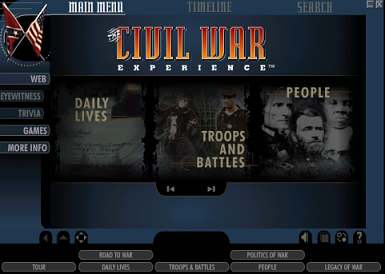 |
Main menu screen of The Civil War Experience.
How to navigate: 28.8K | 56K | Cable/T1 |
|
The Civil War Experience presents a brief overview of the conflict in the format of modern electronic media. The copy on the packaging challenges potential users, "Don't just read about history; experience it!" Odds are that most of those who actually did experience the Civil War would rather have read about it. And, advertising hyperbole notwithstanding, few are likely to agree that watching even such a well-done cinematic piece as the CD's opening 35-second depiction of the first shots of the war at Fort Sumter is quite the same as experiencing the war. In any case, the user will find that most of the information on this disc is presented as text that one must read on-screen. Unlike text in a book, however, the user accesses this text by pointing and clicking on a given topic. Accompanying and enlivening the text are small portions of narration, sound effects, and music. Generally the music is used briefly, as background, to introduce a particular topic. However, in one instance it is the subject itself. A subtopic on Music under the general heading of Daily Lives allows users to listen to Lorena and Dixie in renditions that apparently aim at reproducing an authentic "down home" sound.
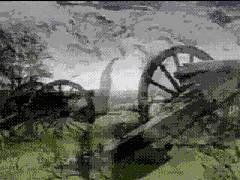 |
Frame from video segment on Gettysburg.
Source: The Civil War Experience.
28.8K | 56K | Cable/T1 |
|
Other major topics include the Road to War, Troops and Battles, Politics of War, People, and Legacy of War. Under each major topic are a number of subtopics, some begining with a single narrated sentence representing the words of one of the participants. For example, under the major topic Legacy of War, the subtopic on Battlefield Preservation begins with an actor representing Abraham Lincoln reading a few lines from the Gettysburg Address—while crickets can be heard chirping in the background. Under the major topic of Politics of War, the subtopic on the Crittenden Compromise begins with an actor reading a few lines from one of Crittenden's proposed constitutional amendments. In contrast, the section on Troops and Battles offers no introductory narration, but only a bit of miscellaneous drill-field noise as background to the section's main menu. More or less appropriate background sounds also help introduce a number of the subtopics under the heading of Daily Lives.
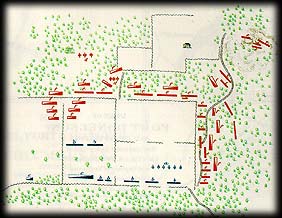 | |
Battle map from The Civil War Experience. |
|
By proceeding through the various major topics and subtopics in order (a process that takes a very long time—definitely more than one sitting), one can read a brief, more or less continuous, history of the war, at least as pertains to political and cultural topics. The greatest shortcoming of the disc is its thin treatment of military history. This was, after all, a war. Yet only a single subtopic within the section on Troops and Battles deals with important campaigns and then only with eight of the most famous: Appomattox, Antietam, Atlanta, Fort Sumter, Gettysburg, Petersburg, Shiloh, and Vicksburg. While the subtopics within such other general headings as Road to War and Politics of War are arranged in sensible chronological order, these battles are simply listed in alphabetical order. The user would have no way of discovering their proper order without exploring each one individually. Each battle is introduced with a discussion of the circumstances that led to it, presented in both narration and in written form. The reader may then select several maps with moving lines representing the armies' lines of battle during different phases of each conflict. These are appealing, but one is left wishing they presented a detailed and more precise time frame. For example, the Gettysburg map deals with all the action between dawn and 6:30 p.m., July 2, in a single map animation. Also available here, as in most other sections, is an eyewitness tab. Clicking this tab activates a brief eyewitness account read by an actor or actress. Unfortunately, the eyewitness account of the Atlanta Campaign is obviously a reference to the March to the Sea. Otherwise, factual errors seem to be few, but some will disagree with a few of the interpretations. The battle presentations would be greatly improved if accompanied by narration explaining the moving maps and the action they depict. Conversely, the narrated introductions would profit from the addition of maps illustrating the armies' approach to the battlefield. Above all, the section should have included at least twice, if not three times as many battles.
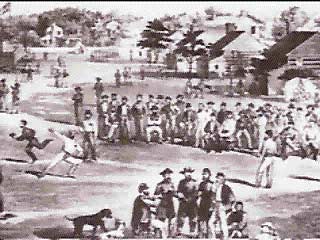 |
The social history of the Civil War: baseball video segment.
Source: The Civil War Experience.
28.8K | 56K | Cable/T1 |
|
Corresponding to the CD-ROM's weak coverage of military history is a heavy emphasis on social history, both in the section on Daily Lives and in a number of subsections to other major headings—for example; the section on Troops and Battles includes a subheading on Ethnic Regiments. The disc accords heavy emphasis to women and minorities, including coverage of women's suffrage and related matters that had no real connection to the war or the sectional crisis.
In addition to the main topics, the CD-ROM offers several other ways to "experience" the Civil War. It includes a time-line of the war, although the time-line graphics make it rather difficult to use. Events are represented merely by dots on the line, and the user does not learn what the event is before clicking the dot. A number of trivia questions are also available, usually one or two for each of the regular topics. These are multiple-choice questions presented in both written and narrated form. Finally, the disc offers two games. It is unlikely that anyone will buy this CD-ROM for the sake of the games, and that is just as well. They could be described as a Civil War version of the old space invaders game—solitaire with cannons.
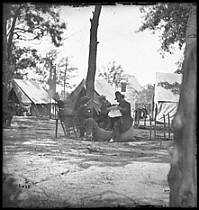 |
Soldiers reading.
From The Civil War Experience. |
|
The disc also comes with a one-year subscription to The Civil War Experience "premium Web site." The site offers still more information and graphics and also allows users to download up-dates for the CD. Of particular note on the Web site were several fairly extensive collections of soldiers' letters, which proved interesting and useful.
Despite the quibbles mentioned above, The Civil War Experience proves to be an appealing, interesting, entertaining, and usually accurate evocation of the Civil War for those who prefer a multi-media, nonlinear presentation. However, it is no substitute for a good book.
Steven E. Woodworth and Brian Melton
Texas Christian University
~ End ~ CD-ROM
Review of The Civil War Experience
Copyright © 2000, 2001 by The Journal for MultiMedia
History
Comments
| JMMH
Contents |




